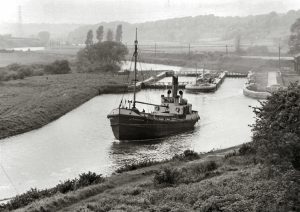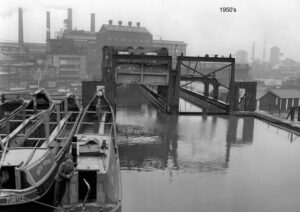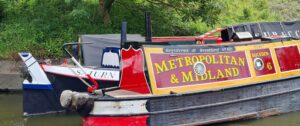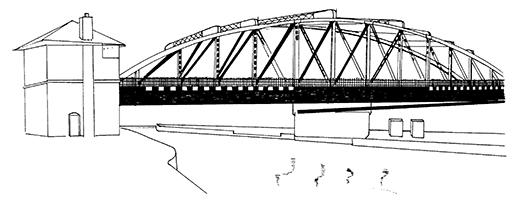 A brief overview of the Weaver Navigation
A brief overview of the Weaver Navigation
The River Weaver was “improved” in the 18th century to facilitate the transportation of salt, coal, and other goods between the industrial towns of Cheshire and the ports of the River Mersey. The River Weaver Navigation opened in 1732, becoming one of the UK’s earliest and most successful navigations.
The Navigation rapidly evolved into a vital transportation artery for Cheshire and its neighbouring regions. During its early era, a series of enhancements and expansions shaped its significance. Navigational infrastructure, including locks, weirs, and sluices, underwent continuous improvements to optimize boat passage and water management.
Salt manufacturing in Cheshire soared, driven by the river’s efficiency in transporting this valuable commodity to markets. Additionally, strategic connections were forged with other waterways, notably the Trent and Mersey Canal in 1777, augmenting the Navigation’s reach and enhancing its utility for trade and commerce.
Despite increasing competition from railways, the Navigation adapted by modernizing its operations. Ultimately, this early period laid the foundation for the River Weaver Navigation’s later prominence during the industrial boom of the 20th century.
 The Anderton Boat Lift
The Anderton Boat Lift
The Anderton Boat Lift opened in 1875, linked the Weaver Navigation to the Trent and Mersey Canal via a two-caisson lift near the village of Anderton. It provides a 50-foot (15.2 m) vertical link. The structure is designated as a scheduled monument and is also known as one of the Seven Wonders of the Waterways. The boat lift was in use for over 100 years until it was closed in 1983 due to corrosion. The RWNS was active it its restoration, started in 2001, and the boat lift re-opened in 2002.
W J Yarwood
Thanks to the Navigation, Northwich was long associated with shipbuilding. The best known business was founded by Northwich blacksmith William James Yarwood. He purchased the former John Thompson shipbuilding business and founded W J Yarwoods and Sons. Customers included the Manchester Ship Canal Company and the Brunner Mond, which became a part of ICI. Over 1,000 vessels were built before the last one, 168-ton diesel tug, the St Elmo, left the yard in 1965. Watch a short 1934 amateur film here.
Industrial Heyday (1900s-1960s)
In the early 20th century, the Weaver Navigation thrived as an essential transportation route for industries such as salt mining, chemicals, and manufacturing. The river saw increased traffic with the development of large salt and chemical works, notably the ICI Winnington works. It also connected to the Manchester Ship Canal, enhancing its role in the broader industrial landscape.
Decline and Modernization (1970s-1990s)
However, as the UK’s industrial base declined, so did the importance of the Weaver Navigation for freight transport. The navigation faced competition from road and rail, which offered faster and more flexible transportation options. By the late 20th century, the Navigation was primarily used for leisure boating and tourism.
 Environmental Restoration, Recreation and Tourism (2000s-Present)
Environmental Restoration, Recreation and Tourism (2000s-Present)
The 21st century witnessed a significant shift in the river’s role. There was growing recognition of the need to restore the Weaver Navigation’s ecology and water quality. Efforts to clean up pollution and rejuvenate the river’s ecosystem gained momentum. Projects focused on improving water flow, habitat restoration, and biodiversity, including the creation of fish passes and wetland areas.
With the decline of industrial traffic, the Weaver Navigation’s scenic qualities came to the forefront. The river became a popular destination for boating, fishing, and recreational activities. Canal side developments and marinas began to spring up, catering to the growing number of leisure users. And its always a pleasure to see the restored steamship Daniel Adamson on the river, listen out for the deep whistle.
The Weaver Navigation Today and Tomorrow
The modern history of the River Weaver Navigation reflects a transformation from an industrial workhorse to a revitalized waterway, celebrated for its natural beauty and recreational opportunities. Its journey from an industrial hub to an environmental asset illustrates the changing priorities and values of society in the 20th and 21st centuries. Today, the Weaver Navigation continues to play a vital role in connecting communities, supporting local economies, and preserving the natural heritage of Cheshire.
Further information:
Northwich and District Heritage Society has several publications, including a history of Yarwoods (£5) and accounts of the 1946 Flood (free PDF).
If you have a favourite picture of the River Weaver, do send it to us (comms@rwns.co.uk). The picture below is one of our favourites.


